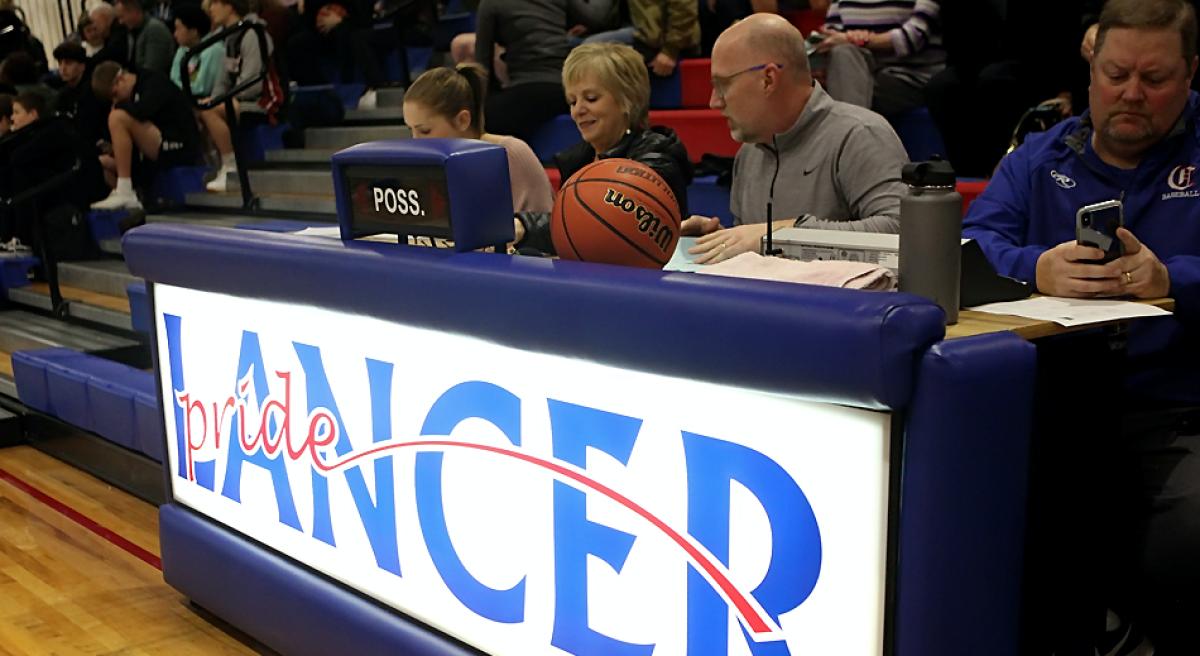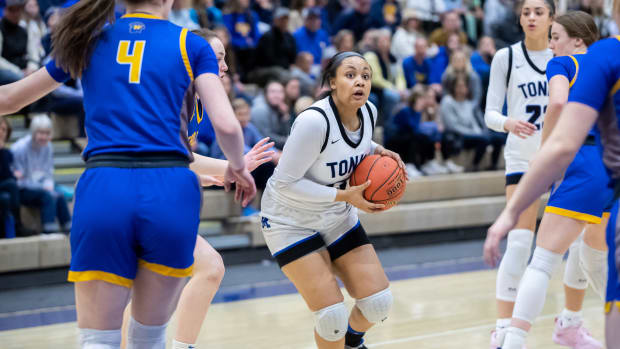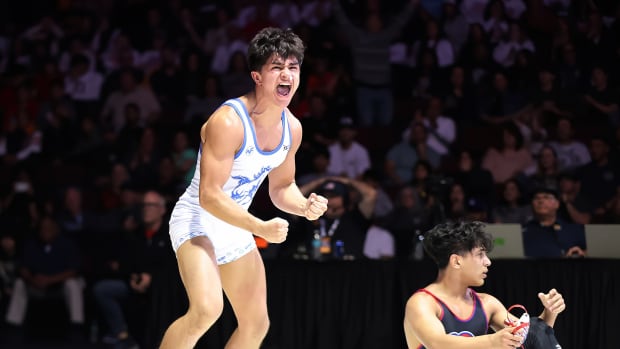
A shot clock is (likely) coming to Oregon high school basketball … what are the pros and cons?
By Bob Lundeberg | Photo by Michele Bunch
Momentum is building to bring a shot clock to Oregon high school basketball.
Last spring, the National Federation of State High School Associations approved a new rule permitting states to adopt a 35-second shot clock beginning in the 2022-23 season. Several states — including California and Washington — bypassed NFHS rules long ago to add shot clocks, but the organization’s 2021 decision added fuel to the fire for shot clock advocates in places like Oregon.
“We recently did a statewide survey of coaches at all levels, and there was a distinct majority that voted for the implementation of a shot clock,” South Medford girls coach Tom Cole said. “I personally feel like it mirrors what the game has evolved to at the highest levels of college and beyond. Being a team that travels quite a bit, we are surrounded by states that also utilize the shot clock. So, it feels like a good geographical fit as well.”
Added Lake Oswego boys coach Marshall Cho: “When we go to California or Washington, we play with a shot clock. For us to be behind on the West Coast, I think it hurts our kids in the long run.”
California and Washington both implemented a shot clock for girls basketball in the 1970s. California added one for boys in 1996; Washington did the same in 2009.
Following the NFHS’s ruling, Montana and Utah voted to begin using a shot clock for the 2022-23 season. Idaho has signed off on shot clocks for state tournament play starting in 2024.
The Oregon School Activities Association executive board tabled a shot clock proposal without a vote at its May meeting, but there is a growing sense among coaches that the state will adopt one for the 2023-24 season. The next OSAA board meeting is scheduled for July 18.
“A shot clock has been discussed in the past, but never to the point where the board would actually vote on it,” said West Albany boys coach Derek Duman, president of the Oregon Basketball Coaches Association. “The board did table it, but it sounds like there will be a vote or decision soon.”
At the conclusion of the 2021-22 basketball season, the OBCA conducted a coaches survey on a variety of topics, including a shot clock. The question was phrased: “Are you in favor of implementing a shot clock?,” with the possible answers of “yes”, “no” or “no preference.”
Of the 297 coaches who responded, 74.1 percent voted “yes.” “No” received 16.5 percent of the tally while 9.4 percent voted “no preference.” The survey also asked coaches to rank issues based on level of importance, and a shot clock topped the list of 160 responders (53.9 percent).
“One of the reasons we have started really advocating for a shot clock is not because of the way any of our board members feel, but because our coaches overwhelmingly support it,” Duman said. “Seventy-four percent is very high, especially when you think about the amount of things coaches disagree on. The other thing I thought was interesting was the 10 percent voting no preference. That swings both ways, but it tells me that 84 percent of coaches either want a shot clock or don’t care.”
While the majority of coaches favor modernization, there are dissenting voices in the room. Toledo boys coach Bart Rothenberger is one of them.
Rothenberger, a seasoned veteran with more than 20 years of head coaching experience, is concerned about the expense of adding shot clocks to gyms — initial costs run anywhere between $2,000 and $20,000 depending on several factors — and finding volunteers to run them. But just as important, Rothenberger wants to know what is wrong with the current state of Oregon high school basketball.
“I’m an old guy, and us old guys feel like it’s going to take away from the game of basketball,” said Rothenberger, who sees the shot clock issue as a disagreement between generations. “I hear that it would cut out stalls, but I’ve gone back and tried to look at how many people are stalling, and you really don’t see it for longer than 30 seconds. What you see are teams that are well-coached that work the ball around and look for a good shot; that’s good coaching and what we do.”
The Crescent Valley girls did exactly what Rothenberger describes in the 5A state championship game. Springfield used a 1-3-1 zone for nearly the entire game, and the Raiders patiently passed the ball around to find the best possible shot. The strategy worked to perfection as Crescent Valley won 50-39 behind 31 points from Gabby Bland, who finished 7 of 10 from three-point range.
Raiders coach Eric Gower, who supports the addition of a shot clock, felt his team was too passive at times during the season, including the state championship game. He believes a shot clock would force his naturally patient group of players to be more aggressive on the offensive end.
“Overall, I just think it will be good for basketball to get the game up and down a little bit more,” Gower said. “There will be an adjustment period for sure, but I think once the kids get used to it, it will be for the best.”
In the 6A girls semifinals, Barlow held on for a narrow 44-42 victory over South Medford despite going more than six minutes in the fourth quarter without a field goal attempt. The stall didn’t work as South Medford overcame a 15-point deficit to tie the score late, but the Bruins survived to secure the first final appearance in program history.
“You can’t criticize the other team for their strategy, because it’s allowable,” said Cole, who also brought up the infamous 2012 5A title game between Willamette and Springfield. The Millers, led by No. 1 national recruit and future Tennessee star Mercedes Russell, won 16-7 as Willamette deployed an all-out stall.
“It’s a particular strategy, Barlow was very successful with it and it does take some skill to do that, it really does. … Now, do I think that makes for as exciting of a basketball game? No, I don’t.”
Rothenberger doesn’t see anything wrong with a team slowing down the tempo to protect a fourth-quarter advantage.
“We worked three-and-a-half quarters to get a 10-point lead, so now we don’t have the opportunity to pull the ball out and make them come out and guard us?” said Rothenberger, who led 1A Mohawk to four state titles between 2002 and 2008. “That’s called coaching, and to me that’s taking coaching out of the game. But they all think it’s good because it speeds up the tempo and gives a team down 10 a chance to come back.
“These younger coaches were raised in the time of AAU basketball, and AAU basketball is 1-on-1, 1-on-5. Same with the NBA. If you watch the playoffs, it’s all screen and roll. We’re not seeing much offense going on, and we’re definitely not seeing defense. I mean, just look at the Golden State Warriors — they gave up (132) points the other night.”
Despite his complaints, Rothenberger is resigned to the fact that a shot clock is coming. While the majority of 2A coaches did vote against it, 1A coaches overwhelmingly support adding a shot clock; Duman said more than 90 percent of surveyed 6A and 5A coaches want a shot clock.
Cho, who expressed empathy toward the financial and staffing challenges a shot clock would have on smaller schools, is excited about the potential out-of-game impacts of a shot clock.
“It would change how we run our practices, our offenses, our defenses,” Cho said. “Aesthetically for the general public, it won’t be as dramatic as what they think. There are a lot of things unseen by the common eye that the shot clock will bring.”
As his closing argument, Rothenberger noted that a shot clock will favor the better, more talented team. Extra possessions mean more opportunities to score, and Rothenberger believes this will lead to bigger blowouts.
But Rothenberger and Cho do agree on one thing: The actual on-court product will largely remain the same with or without a shot clock.
“Is it really going to change that much? Honestly, probably not,” Rothenberger said. “So, I’ll just bite the bullet and hope that my guys are more athletic than theirs.”






